![This shows the step-by-step solutions to the exponential equation: 5^(2x) = 21. log of base 5 of [5^(2x)] = log of base 5 of 21 ==></p>
<p>2x * log of base 5 of 5 = log of base 5 of 21 ==> 2x = log of base 5 of 21 ==> x = (log of base 5 of 21)/2 ==> That gives as that x is approximately equal to x ≈ 0.9458.](https://www.chilimath.com/wp-content/uploads/2017/07/ex1_s1-3.png)
In our previous lesson, you learned how to solve exponential equations without logarithms. This time around, we want to solve exponential equations requiring the use of logarithms. Why? The reason is that we can’t manipulate the exponential equation to have the same or common base on both sides of the equation. If you encounter such type of problem, the following are the suggested steps:
1) Keep the exponential expression by itself on one side of the equation.
2) Get the logarithms of both sides of the equation. You can use any bases for logs.
3) Solve for the variable. Keep the answer exact or give decimal approximations. In addition to the steps above, make sure that you review the Basic Logarithm Rules because you will use them in one way or another.
Let’s go over some examples!
Example 1: Solve the exponential equation [latex]> = 21[/latex].
The good thing about this equation is that the exponential expression is already isolated on the left side. We can now take the logarithms of both sides of the equation. It doesn’t matter what base of the logarithm to use. The final answer should come out the same. The best choice for the base of log operation is [latex]5[/latex] since it is the base of the exponential expression itself. However, we will also use in the calculation the common base of [latex]10[/latex], and the natural base of [latex]\colore[/latex] (denoted by [latex]\colorln[/latex]) just to show that in the end, they all have the same answers.
![This shows the step-by-step solutions to the exponential equation: 5^(2x) = 21. log of base 5 of [5^(2x)] = log of base 5 of 21 ==></p>
<p>2x * log of base 5 of 5 = log of base 5 of 21 ==> 2x = log of base 5 of 21 ==> x = (log of base 5 of 21)/2 ==> That gives as that x is approximately equal to x ≈ 0.9458.](https://www.chilimath.com/wp-content/uploads/2017/07/ex1_s1-3.png)
![This is a complete solution to the exponential equation 5^(2x) = 21. We have 5^(2x) = 21 ==></p>
<p>log of base 10 of [5^(2x)] = log of base 10 of 21 ==>(2x) * log base of 10 of 5 = log base of 10 of 21 ==> 2x = (log of base 10 of 21)/(log of base 10 of 5) ==> x = [(log base 10 of 21)/(log base 10 of 5)] / 2 ≈ 0.9468. Therefore x is approximately equal to the decimal number 0.9458.](https://www.chilimath.com/wp-content/uploads/2017/07/ex1_s2-2.png)
Example 2: Solve the exponential equation [latex]2\left( >> \right) = 12[/latex] .
As you can see, the exponential expression on the left is not by itself. We must eliminate the number [latex]2[/latex] that is multiplying the exponential expression. To do that, divide both sides by [latex]2[/latex]. That would leave us just the exponential expression on the left, and [latex]6[/latex] on the right after simplification.
/2 = 12/2 ==> 3^(x-5) = 6 which is a less intimidating exponential equation to work with." width="106" height="91" />
It’s time to take the log of both sides. Since the exponential expression has base [latex]3[/latex], that’s the convenient base to use for log operation. In addition, we will also solve this using the natural base [latex]e[/latex] just to compare if our final results agree.
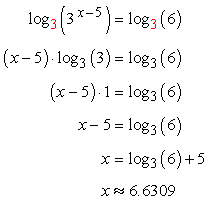 We will solve the exponential function 3^(x-5) = 6 using logarithm of base 3. log of base 3 of 3^(x-5) = log of base 3 of 6 ==>
We will solve the exponential function 3^(x-5) = 6 using logarithm of base 3. log of base 3 of 3^(x-5) = log of base 3 of 6 ==>
(x-5) * log of base 3 of 3 = log of base 3 of 6 ==> (x-5) = log of base 3 of 6 ==> x-5 = log of base 3 of 6 ==> x = log of base of 3 of 6 + 5 ==> x ≈6.6309. The final solution to the exponential equation is x is approximately equal to 6.6309." width="208" height="201" />
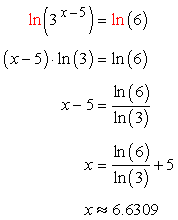 We will solve the same exponential equation using base e (also known as the Euler" width="178" height="220" />
We will solve the same exponential equation using base e (also known as the Euler" width="178" height="220" />
Example 3: Solve the exponential equation [latex]2\left(<\Large<<<<
This looks like a mess at first. However, if you know how to start this out, the solution to this problem becomes a breeze. What we should do first is to simplify the expression inside the parenthesis. Use the Division Rule of Exponent by copying the common base of [latex]e[/latex] and subtracting the top by the bottom exponent.
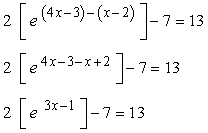
-7 = 13 ==> 2 * < e ^[(4x-3)-(x-2)] >- 7 = 13 ==> 2 ^ [ e^(4x-3-x+2)] -7 = 13 ==> 2 [ e ^(3x-1) ] - 7 = 13." width="208" height="133" />
Now isolate the exponential expression by adding both sides by [latex]7[/latex], followed by dividing the entire equation by [latex]2[/latex].
![To continue solving the above exponential equation, we have: 2 [ e ^ (3x-1) ] =20 ==></p>
<p>e^(3x-1) = 10.](https://www.chilimath.com/wp-content/uploads/2017/07/ex3_s2-2.png)
Take the logarithm of both sides. Use [latex]\colorln[/latex] because we have a base of [latex]e[/latex]. Then solve for the variable [latex]x[/latex].
![Finally, to finish it off, we will solve it as usual by getting the natural logarithm of both sides of the equations: ln [ e ^ (3x-1) ] = ln (10) ==></p>
<p>(3x-1) * ln (3) = ln (10) ==> (3x-1) = ln (10) ==> 3x-1 = ln (10) ==> 3x-1 = ln(10) ==> 3x = ln(10) + 1 = x = [ln(10)+1]/3 ==> x ≈ 1.1009. So that means x is approximately equal 1.1009.](https://www.chilimath.com/wp-content/uploads/2017/07/ex3_s3.png)
Example 4: Solve the exponential equation [latex]<\left( <<<10>^>> \right)^x> + 3 = 53[/latex] .
Observe that the exponential expression is being raised to [latex]x[/latex]. Simplify this by applying the Power to a Power Rule. Do that by copying the base [latex]10[/latex] and multiplying its exponent to the outer exponent. It should look like this after doing so.
We can now isolate the exponential expression by subtracting both sides by [latex]3[/latex] and then multiplying both sides by [latex]2[/latex].
![(1/2) * [10^(x^2-x)] + 3 = 53 ==></p>
<p>(1/2) * [10 ^ (x^2-x)] = 50 ==> 10^(x^2-x) = 100](https://www.chilimath.com/wp-content/uploads/2017/07/ex4_s2.png)
Take the logarithm of both sides with base [latex]10[/latex]. If you just see a [latex]\colorlog[/latex] without any specific base, it is understood to have [latex]10[/latex] as its base.
![log [ 10 ^ (x^2-x) ] = log (100) ==></p>
<p>(x^2-x) * log (10) = log (100) ==> (x^2-x) = 2 ==> x^2 - x = 2](https://www.chilimath.com/wp-content/uploads/2017/07/ex4_s3.png)
We are going to solve this quadratic equation by factoring method. Let’s move everything to the left side, therefore making the right side equal to zero. Factor out the trinomial into two binomials. Set each binomial factor equal zero then solve for [latex]x[/latex].
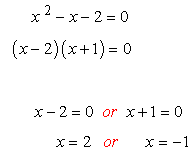
Example 5: Solve the exponential equation [latex]> – 7 + 10 = 0[/latex].
We will need a different strategy to solve this exponential equation. Observe that we can actually convert this into a factorable trinomial. First, we let [latex]m = [/latex]. Rewrite the exponential expression using this substitution.
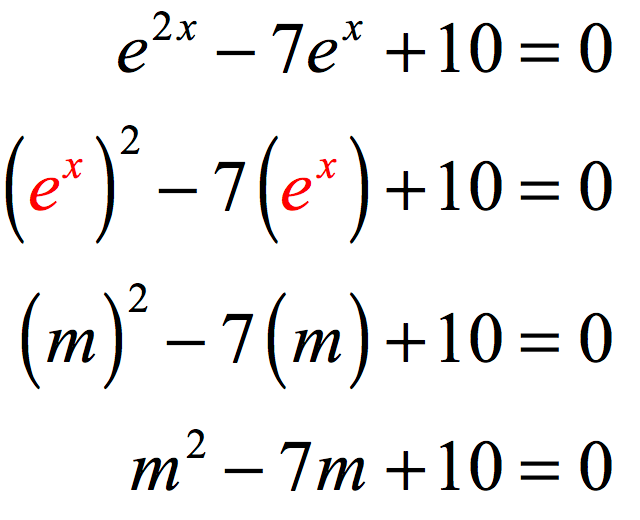
(e^x)^2 - 7 * (e^x) + 10 =10. Let m = e^x, this transforms the equation into a simpler quadratic equation where the trinomial on the left side of the equation is easily factorable. m^2 - 7m + 10 = 0." width="640" height="520" />
Factor out the trinomial as a product of two binomials. Then replace [latex]m[/latex] by [latex]e^x[/latex] again.
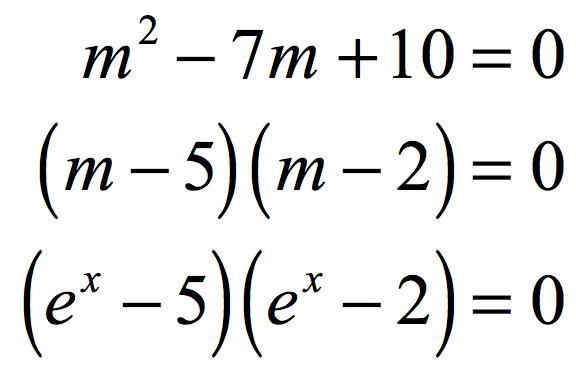
Finally, set each factor equal to zero and solve for [latex]x[/latex], as usual, using logarithms.
e^x = 5 ==>ln(e^5) = ln(5) ==> x * ln(e) = ln(5) ==> x * 1 = ln(5) ==> x = ln(5) where x ≈ 1.6097. For the second equation, we have the transcendental equation e^x -2 = 0 ==> e^x = 2 ==> ln(e^x) = ln(2) ==> x * ln(e) = ln (2) ==> x * 1 = ln(2) ==> x = ln(2). That means x is approximately equal to 0.6932 or x ≈0.6932." width="355" height="265" />
You might also like these tutorials:
Categories